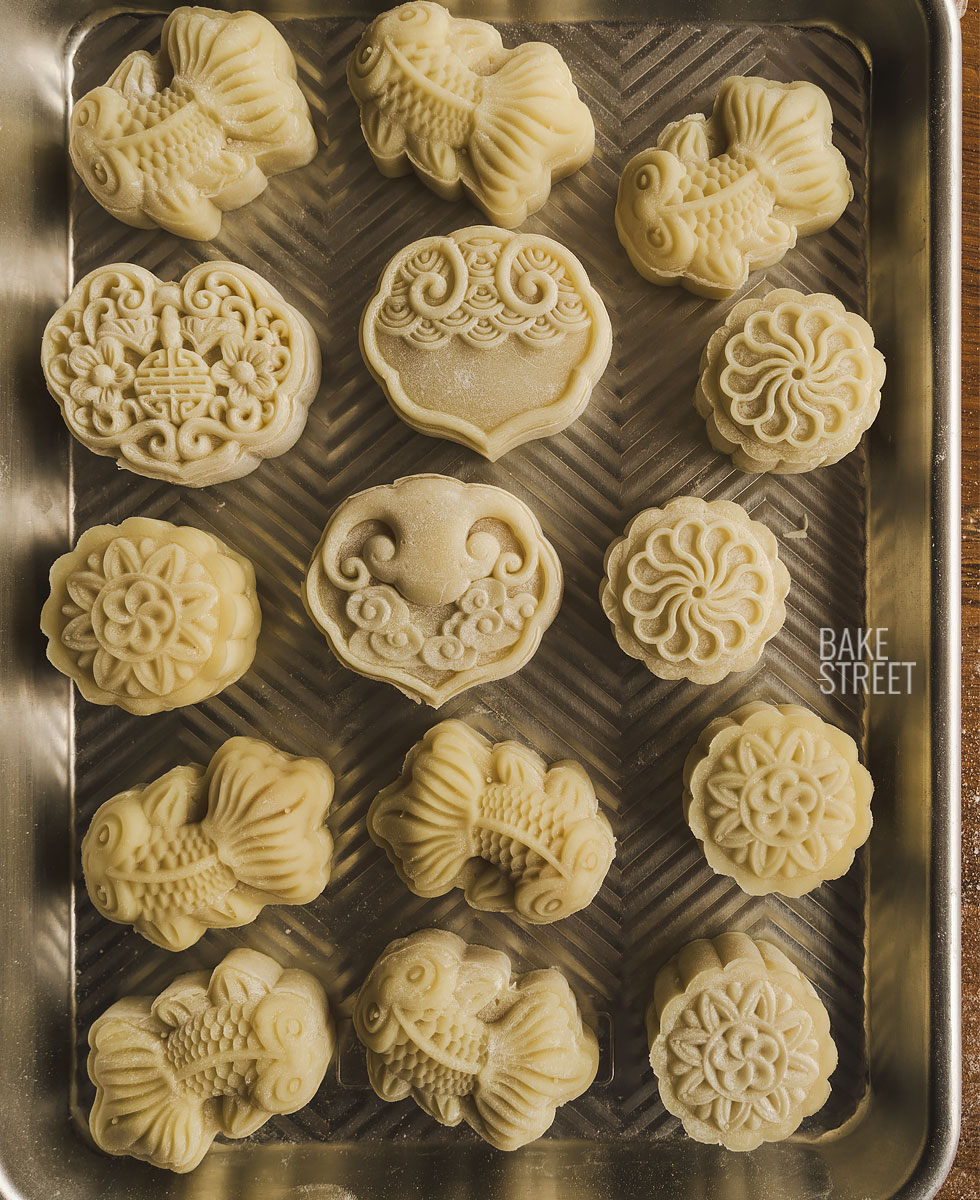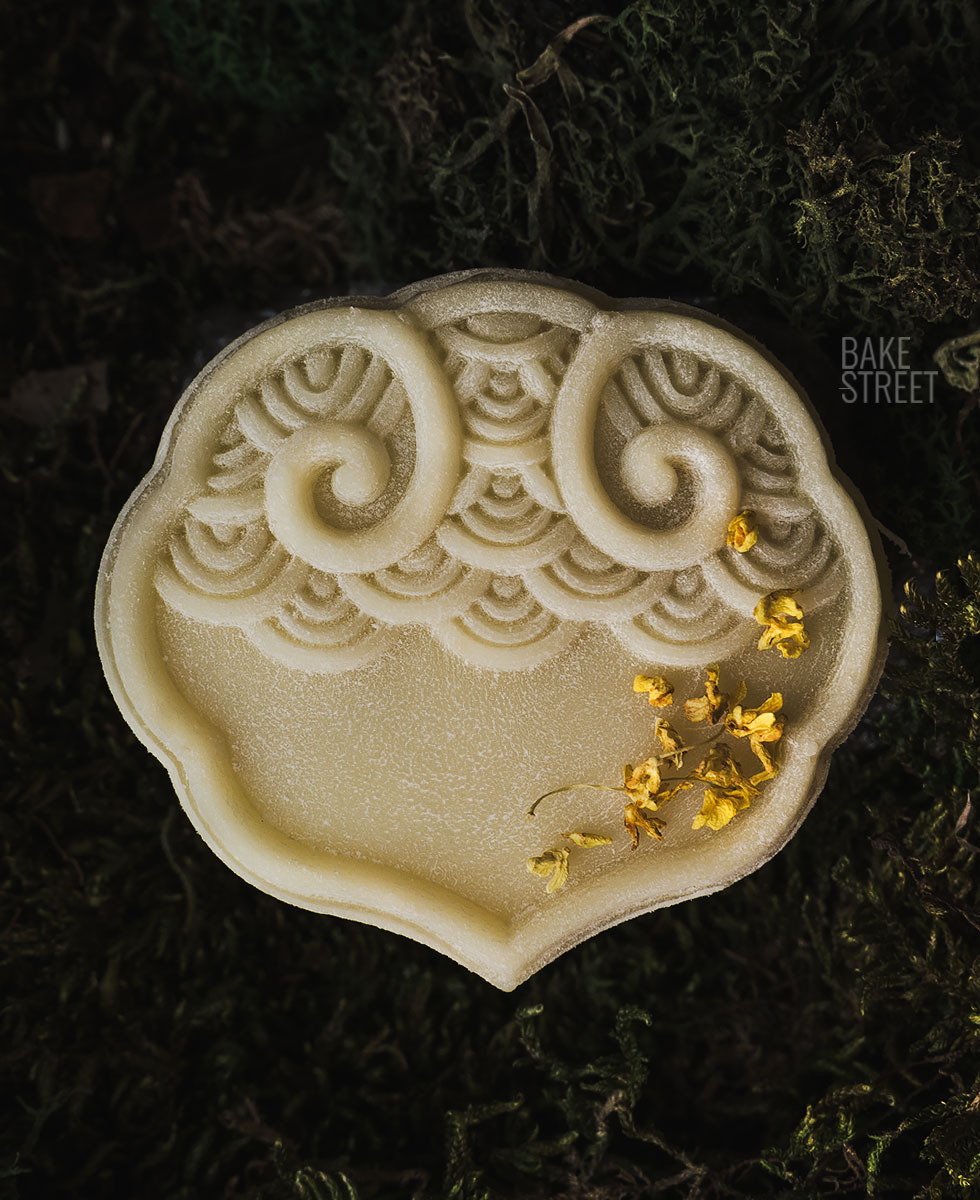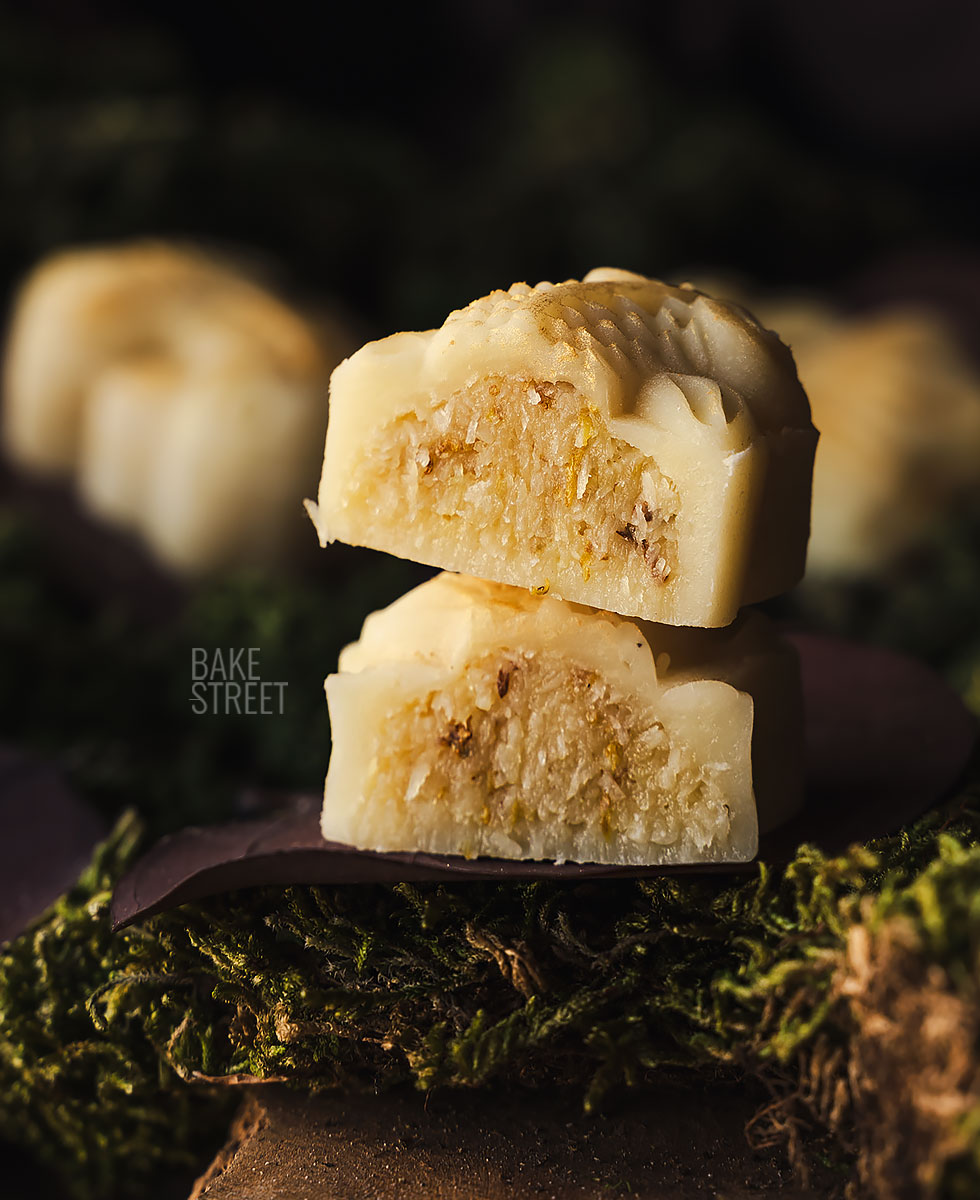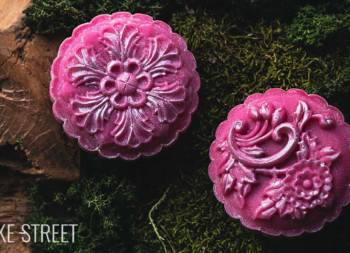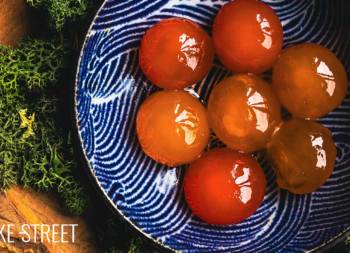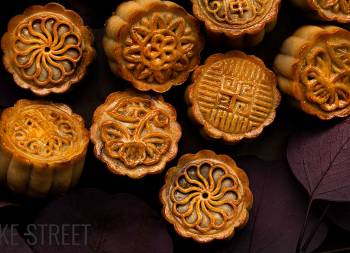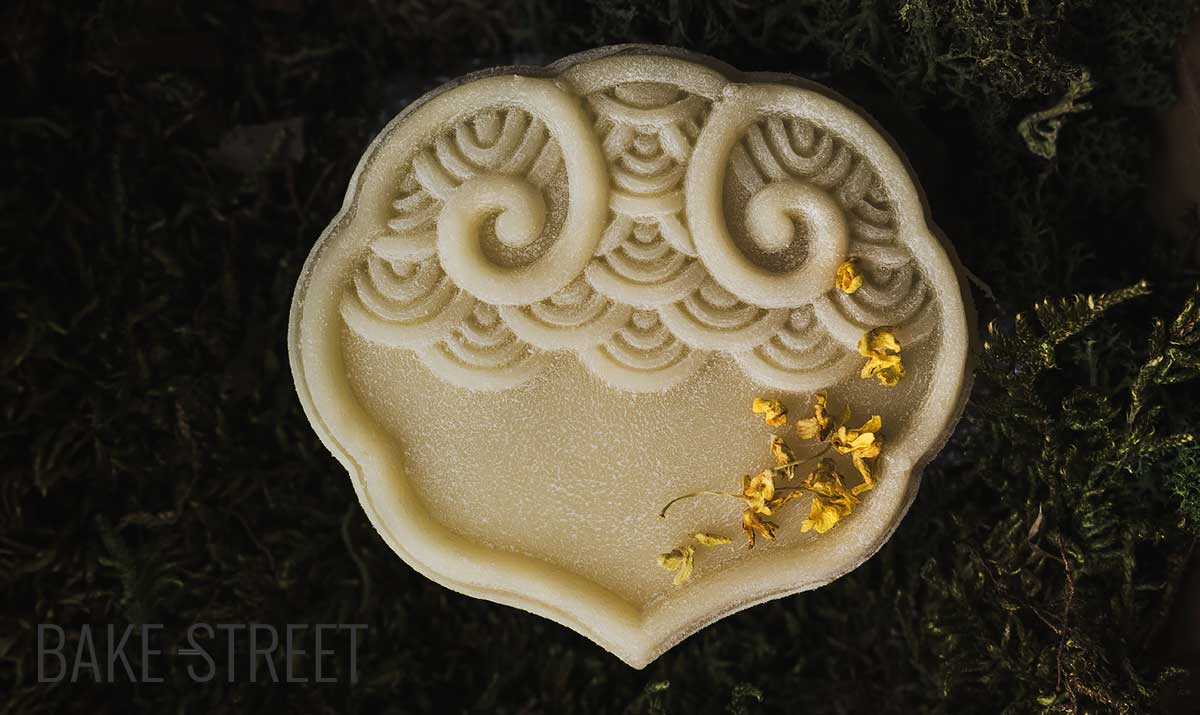
Osmanthus and Coconut Snow Skin Mooncakes
It’s going to become a tradition to come back from holidays, return to the blog and leave you with a recipe for mooncakes. But, it is more than a coincidence since my return from summer is usually around the celebration of the Mid-Autumn Festival (this year 2024 is on the 17th of September), so I feel obliged to leave you a new recipe to celebrate this wonderful day. This time I bring you Osmanthus and Coconut Snow Skin Mooncakes .
Last year, after my insatiable search for the Sakura flower to make the Sakuan-An paste, I came across the osmanthus flower. As you may have guessed, I made a note of this marvel, searched for it and located it so that I could leave you with a recipe for it the following year. In fact, I had a recipe for a mooncake filling with it, but I lost it…
I’m not going to lie to you if I tell you that I was a bit overwhelmed because I had everything ‘prepared’, just waiting to pass the recipe on, check it and try it out. But I couldn’t find the website where the recipe was to be found. So I started a new search that led me to a girl I already knew who had some mooncakes with this flower. From here I thank you, Jasma, for your fantastic work, so clear, clean and original.

Osmanthus flower.
My great passion is cooking, but what I like most about my profession is that it allows me to link many other hobbies/passions I have; photography, creating/editing videos, music, modelling, growing vegetables and flowers. I have a few more, but I won’t go on too long.
I dream of having a farm where I can grow a thousand things and even make videos about it, I see myself like that in a few years and I hope to make it happen. The fact is that I am fascinated by flowers because I believe that each one has a hidden essence, but that we do not have the ability to see with the naked eye. The beauty of things goes beyond their simple appearance.
The osmanthus flower (Osmanthus fragans) is a fascinating plant, rich in history, symbolism and cultural uses, especially in Asia.
Also known as fragrant olive or sweet olive, it is a plant native to East Asia, particularly China, Japan, Taiwan and the Himalayas. The plant belongs to the Oleaceae family and is known for its characteristic sweet and fruity fragrance, reminiscent of a blend of peach, apricot and jasmine.
The origin of its name comes from the Greek, where ‘osme’ means ‘fragrance’ and ‘anthos’ translates as ‘flower’, highlighting one of its main characteristics: its powerful and pleasant aroma. This fragrance is especially noticeable in the autumn months, as this is when the plant flowers.
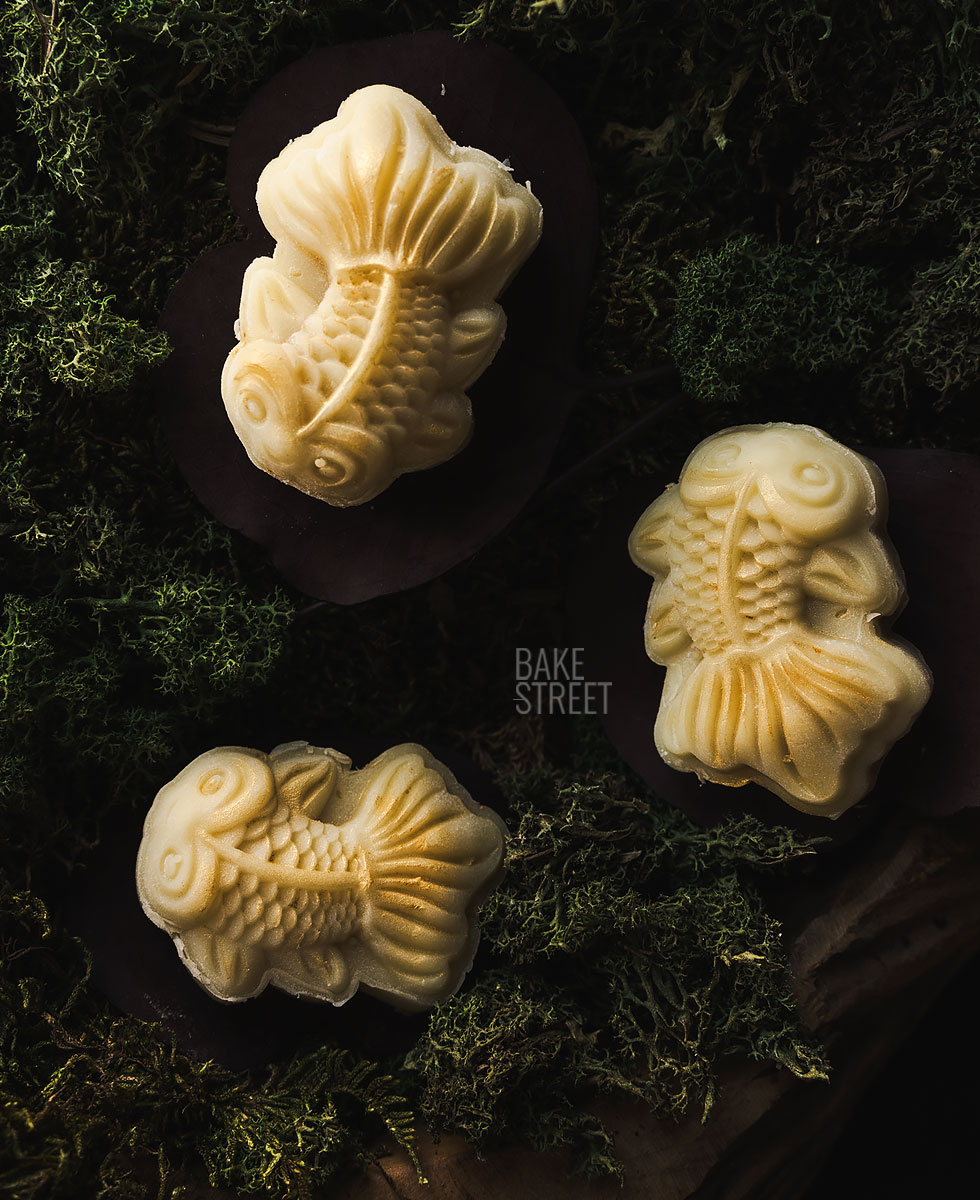
Tradition and culture.
In China, the osmanthus flower has a very special place in the culture and traditions. It has been cultivated for more than 2,500 years and is seen as a symbol of love, prosperity and longevity. In fact, it is a floral emblem of Guilin, considered the most beautiful city in China. It is famous for its osmanthus which bloom in great numbers every autumn, filling the air with their sweet perfume.
The flower is also closely associated with the Mid-Autumn Festival (or Moon Festival), which celebrates the harvest and family reunion. During this festival, it is traditional to drink osmanthus wine or osmanthus tea and enjoy mooncakes, which may also be scented with osmanthus.
In traditional Chinese medicine, osmanthus is used for its medicinal properties. It is believed to help improve digestion, relieve colds and cleanse the lungs. It is also used to calm anxiety and improve mood, thanks to its delicate and relaxing aroma.
According to Chinese mythology, a huge osmanthus tree grows on the moon, which is constantly cut down by the immortal Wu Gang as punishment for his reckless behaviour, but the tree magically regenerates itself again and again.
In Japan, the osmanthus is known as ‘kinkan’ or ‘kinmokusei’ in Japanese, a plant often found in gardens and parks. In Japanese culture, it symbolises elegance, purity and is associated with the changing seasons and the transient nature of life, a central concept in Japanese philosophy.
In addition, the osmanthus appears in Japanese art, where it is frequently depicted in haiku poems and other art forms to emphasise the delicacy of nature and the ephemeral beauty of life.

Symbolism of the osmanthus flower.
This flower has a profound symbolism. Throughout history and in different cultures it has represented qualities ranging from nobility to love and purity.
- Longevity and fortune: In China, osmanthus is associated with longevity and prosperity. This connection stems from the belief that its durability and persistent growth represent a long and prosperous life. It is also believed that bringing osmanthus into the home can attract good luck.
- Love and marriage: In some regions of China, osmanthus is used in wedding ceremonies, as it is believed to represent romantic love and good wishes for a harmonious relationship. Its soft but lingering fragrance is considered a metaphor for lasting love.
- Purity and beauty: In Japan, osmanthus is seen as a symbol of purity and elegance, due to the flower’s delicate fragrance and simple beauty.
- Resilience and rebirth: The Chinese myth of the osmanthus tree growing on the moon, which is repeatedly cut down and regenerates itself, has been interpreted as a symbol of resilience and rebirth, as the tree never stops blooming, regardless of obstacles.
This flower not only boasts beauty and fragrance, but also has a prominent place in Asian cuisine, especially in China. Its dried flowers are used to prepare infusions, syrups, honey, to flavour sweets and savoury dishes, and even in the production of liqueurs such as osmanthus wine.
Osmanthus is also used as an offering at Buddhist temples and family altars, where its fragrance is offered to the gods and ancestors as a gesture of respect and devotion.
If you are curious to know the origin of the Mooncakes, along with their history and legend, you can do it in this post and in this one I talk about the origin of the Snow Skin Mooncakes, the version that I leave you with today.
Recipe Osmanthus and Coconut Snow Skin Mooncakes
Ingredients for 18 mooncakes (13 pieces of 50 g and 5 pieces of 75 g)
SNOW SKIN MOONCAKES:
- 80 g glutinous rice flour
- 80 g rice flour
- 40 g cornstarch
- 300 g whole milk + 6 g osmanthus flower (you will get 280 g infused milk)
- 90 g icing sugar
- 40 g condensed milk
- 60 g unsalted butter, melted and chilled
OSMANTHUS AND COCONUT FILLING:
- 2 large eggs (approx. 130 g)
- 100 g condensed milk
- 60 g osmanthus blossom syrup (recipe below)
- 60 g unsalted butter, melted and cooled
- 200 g desiccated coconut
- 40 g rice flour
- 7 g osmanthus flower
OSMANTHUS FLOWER SYRUP:
- 200 g sugar
- 100 g water
- 10 g osmanthus flower
COVERING:
- toasted glutinous rice flour (in the recipe I show you how to make it)
MATERIAL WE WILL NEED AND VISIBLE IN THE VIDEO:
- bowls
- silicone spatula
- digital kitchen scales
- steamer, I used my crock pot (optional)
- Nordic Ware Naturals tray
- scraper
- pastry brush
- saucepan
- wide frying pan, mine is a De Buyer 28 cm in diameter
- 50 g and 75 g mooncake moulds (you can use whatever you have at home)
REMEMBER TO ENJOY SWEETS IN MODERATION. SUGAR SHOULD BE CONSUMED OCCASIONALLY AND NOT BE PART OF YOUR DAILY DIET TO MAINTAIN A HEALTHY LIFESTYLE.
Elaboración
Prepare osmanthus syrup.
- In a saucepan, add the sugar and water, place over medium-high heat and bring to boil.
- Once it comes to boil, cook for 15-20 seconds and remove from the heat.
- Leave to stand for 10 minutes in the saucepan.
- Pour the syrup into a glass container, preferably a sterilised glass jar, and add the dried osmanthus flowers.
- Mix with a teaspoon to ensure that all the flowers are properly soaked.
- Allow to cool completely at room temperature and then refrigerate for 2-3 days.
- This resting time will help the syrup to become very aromatic.
- NOTE: Before using the syrup to make the coconut filling, I advise you to temper it for 2-3 hours before using it. It is possible that the top may crystallise slightly, just stir it with a spoon.
FIRST DAY
Prepare the osmanthus flower infused milk.
- Heat the milk in a saucepan and bring to boil.
- Remove from the heat and add the osmanthus flowers, mixing with a spoon to help all the flowers soak in. Leave to stand while you prepare the rest of the ingredients, about 3-4 minutes.
Prepare "snow skin" dough for mooncakes.
- In a bowl add all the ingredients except the milk.
- Strain the infused milk to remove the flowers. Press the osmanthus flowers well because they absorb a lot of milk. You should get 280 g of infused milk, if you are short of milk, add more until you reach the specified amount.
- Add the infused milk, which will still be warm/warm, to the rest of the ingredients in the bowl. Mix with a whisk until homogenised.
- Pass the mixture through a sieve to remove and break up any lumps that may have formed. You will obtain a very smooth and silky mixture.
- Pour the mixture into a container that can withstand steaming or one suitable for use in the microwave. Cover the bowl with cling film and pierce the surface.
- You can cook the mixture in two ways; place the pot on medium-low heat and steam (in my case I used the fast cooker with the steam tray) for 35 minutes. Or in the microwave, at maximum temperature for 5-10 minutes.
- You will know the mixture is ready when there is no liquid left in the middle. To do this, insert a knife and it should come out clean and without any liquid mixture. In the case of the steamer, check the state of the dough after 25 minutes and, from this point onwards, keep checking. In the case of the microwave, do it in batches and check the state of the dough after 4 minutes.
- Remember that the shape of the container has an influence, if it is uniform, if it has areas where there is more dough...
- Take the bowl out of the steamer or microwave and transfer it to a dough mixer.
- Mix with the help of the hook, at speed 1-2, for 8-10 minutes.
- You must knead very well to achieve a soft, smooth, homogeneous and elastic dough. The better it is kneaded, the less sticky it will be.
- If you wish, you can do this process by hand. Last year I showed you how to do it in this post.
- Once the dough is ready, flatten, wrap well in plastic wrap and refrigerate, preferably, for 12-24 hours or a minimum of 2 hours.
Prepare the osmanthus and coconut filling.
- In a large bowl, add the eggs together with the condensed milk, the melted and cooled butter and the osmanthus flower syrup. Mix with a whisk until smooth.
- Add the grated coconut together with the rice flour and the osmanthus flower, mix again until smooth.
Cook the osmanthus and coconut mixture.
- Cook at medium heat (my glass ceramic hob has a range of 1-9 and I cooked it at 5 and 1/2) stirring constantly as it is a filling that sticks easily.
- You should cook it for about 8-10 minutes. I recommend using a thermometer to know the temperature of the filling, it should reach 158ºF/70ºC. This step is important as it contains egg and, once it reaches this temperature, it will be safe for conservation and later consumption.
- Transfer the filling mixture to a large bowl, spread out to allow it to cool first, cover with cling film and leave to cool completely.
Shape balls of the filling mixture for the mooncakes.
- Depending on the mooncake mould or moulds you are going to use, you will have to form the filling pieces in one size or another. Remember that the mooncake should have half the weight of the filling and half the weight of the outer dough.
- In my case I used 50 g and 75 g moulds, so I formed 13 balls of 25 g and 5 balls of 38 g.
- Once they are formed, place in a bowl, cover with film and refrigerate.
- I advise you to keep the filling balls cold if you are not very good at forming mooncakes. As the filling is firm, it makes the forming process much easier.
- NOTE: If you use the cold filling to cover it with the dough, once you have formed the balls of dough and filling, you must let the filling return to temper so that you can shape them with the mooncake mould.
SECOND DAY
Cook the glutinous rice flour to coat the mooncakes.
- In a large frying pan, add the glutinous rice flour and cook over medium heat for 5-7 minutes, stirring constantly.
- Remove from heat, pour into a bowl and allow to cool completely.
Divide the dough to form the mooncakes.
- To form this type of mooncakes, you need the same amount of batter as filling. This step must be adjusted to your moulds. In my case I used.
If you divide the dough 50 g and 75 g moulds, so I formed 13 balls of 25 g and 5 balls of 38 g. - If you divide the dough into pieces, remember to place them in the centre of the piece, bring the ends of the dough to the centre and roll it between both hands. You will get a smooth, soft and shiny piece.
- Roll the piece in cooked glutinous rice flour, remove the excess and place on a tray.
- Repeat the same process with the remaining pieces.
- Once formed, cover with cling film to prevent them from drying out.
Shaping mooncakes.
- Roll a piece over a bowl of cooked glutinous rice flour, remove the excess.
- Place the mooncake mould over the piece and press down firmly 2-3 times.
- Remove the mooncake from the mould, pressing down in the same way as if you were going to mark the cake and place on the tray.
- Repeat the same process with the rest of the pieces.
- NOTE: Keep in mind that some moulds have a shape that is not rounded. In this case, you will have to carefully shape the piece to ensure that it has a similar appearance and that when you place the mould on the piece, it does not rub against any part of the piece as it could crack or damage it. In the video you can watch it in detail.

Decorate, if you wish.
- Before painting or serving the mooncake, if you do not paint it, you must remove any excess rice flour that may remain on the surface or base. To do this, use a pastry brush.
- With the help of a pastry brush, paint the highest parts of the mooncake with gold food colouring powder. Don't try too hard, just add details.
- Serve. If refrigerated, I recommend tempering them for 1 hour so that the filling acquires the right consistency, tender and moist.
- NOTE: These mooncakes should ideally be eaten the same day they are made. They can be kept refrigerated in an airtight container in the refrigerator for 2-3 days. After this time, the outer coating will start to dry out and they will not be as good. They can be frozen, tightly wrapped in film, for 3 months.

Notes
- Neither glutinous rice flour nor rice flour can be substituted for any other variety. Both must be used for optimum results.
- Corn starch can be substituted for another variety of starch if you wish; potato, tapioca...
- When we cook the dough, either steamed or in the microwave, it is completely normal for it to have a greasy appearance. We will have to knead very well to integrate all the ingredients and achieve a smooth and silky finish.
- If you wish, you can dye the batter for a coloured mooncake.
- To make the osmanthus syrup, use dried osmanthus flowers. If you prefer, you can use honey and incorporate the flowers into it. Remember that it must also stand for 2-3 days to infuse and acquire the wonderful aroma of this flower.
- The original recipe for the filling contains coconut milk, in my case I omitted it as the filling is too runny.

- The filling we use for this type of cake must be moldable and not contain too much moisture. Otherwise it would spoil the final result. We can use ankoor lian rong, for example, in case you don´t like the filling I share today.
- This filling can also be used for baked versions of mooncakes. I remind you of this post and this post where I show you how to make mooncakes with baked dough.
- To cover both the outer dough and the filling, and to be able to handle it, we must use glutinous rice flour previously cooked or toasted, not raw.
- It is very important to roll the piece in cooked glutinous rice flour to shape it with the mold, otherwise there is a high risk that the dough will stick to the mold. To remove the excess we will use a pastry brush.
- To make these mooncakes I have used various moulds; 50 g mooncake moulds and 75 g mooncake moulds.
- It is very important to weigh both the dough and the filling. The combined weight of both cannot exceed the amount of dough your pan can tolerate. The amount of filling and dough, for this variety, should be the same.
- If we use fresh fruit inside the mooncake, I do not recommend freezing it. The fruit changes its texture and it is common for it to release water, which would spoil the final result of the product.
- They can be stored, refrigerated, in an airtight container and without stacking the pieces for up to 72 hours. After this time, the outside will begin to dry out and change from a tender texture to a hard, dry one. They can also be frozen, placed in a single layer in an airtight container. Once completely frozen, they can be individually wrapped with cling film or stored in airtight bags for up to 3 months in this case.
- If you freeze them, let them thaw at room temperature for 2-3 hours. This will give them their tender texture.

I hope you enjoy these Osmanthus and Coconut Snow Skin Mooncakes, I assure you that the taste and aroma of these little delights is incredible.
And, for those of you who don't know this flower, I am happy to bring you this cultural gem with a history spanning centuries of traditions in Asia. From its roots in ancient China to its influence on modern cuisine, its symbolism of love, longevity and purity make it an enduring icon in everyday life as well as in art and religion.
Its presence in gastronomy, in festivals such as the Mid-Autumn Festival, and its impact on poetry and mythology make osmanthus a deeply respected and admired flower.
By the way, I remind you that you can watch all my videos on my YouTube channel. If you subscribe and turn on the little bell, I will be eternally grateful!
Lots of love,
Eva
